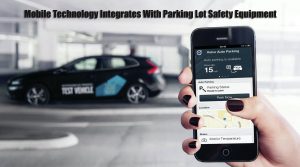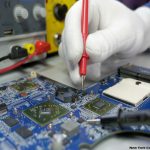Most drivers would agree that nothing can be more devastating than not being able to find a parking space right when they need it. Not only is it a waste of time, fuel, and energy, it also creates traffic congestion and enraged driver.

Here’s how mobile technology would integrate with parking lot safety equipment.
For starters, we can’t deny the fact that drivers across the nation and around the world are starting to utilize websites, mobile apps, and other technological innovations to find a pay parking the easy way.
Major cities in the US are working on ideas on how to simplify the parking process, and if fate allows, mark a revolution in the parking industry.
The Combination of Several Technological Innovations
Engineers are now trying to combine GPS receivers, ultrasonic sensors, and cellular data sensors to come up with a budget-friendly, yet the highly effective solution for finding the nearest available parking space in the area.
By having a well-managed parking data available, this would alleviate traffic problems as travelers would be able to decide where to park or choose another mode of transportation beforehand.
In such a case that drivers opt for street parking, it could be useful as it will suggest parking spaces to users through the use of a navigation system.
To test this out, ultrasonic distance sensors were mounted on the passenger-side doors of vehicles, and utilizing data collected, the researchers were able to come up with an algorithm that analyzes the ultrasound distance readings into a count of vacant parking spaces. The combination of this with GPS data could also generate maps regarding which areas are occupied.
Traffic congestion is a huge issue, and investing in smart parking infrastructure is a good investment. Fixed sensors can be installed in speed bumps, parking meters, and asphalt to detect the presence of vehicles in these parking spots. The problem with this is that it only works for slotted parking spaces and metered parking space.
Likewise, the installation and operating costs aren’t cheap either. That’s why engineers are also devising a prototype of a sensing platform using an ultrasonic sensor that could report the distance to the nearest obstacle, and a GPS receiver capable of noting the corresponding location. These can be connected to a PC or WiFi card to send data to a central receiver.
The detection of parked vehicles is based on the ultrasonic sensor readings. Through this, it would be possible to distinguish parked cars from other objects in the area. Filters were also developed to eliminate dips that have a depth of less than the recommended threshold.
The Use of Detection Data
Integrating detection data with reference maps to produce a spot-accurate map of parking availability. Those who are behind this innovation faced a significant issue through– the fact that location coordinates offered by a GPS receiver could only gather up to 3 meters.
That means if it’s beyond that, it might be difficult to gather accurate data anymore. That’s why another algorithm was developed, and this uses high readings to find specific objects, like trees and street signs.







